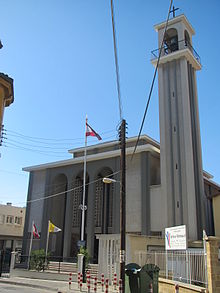Maronite Catholic Archeparchy of Cyprus
|
Archeparchy of Cyprus (Maronite) Archeparchy Cyprensis Maronitarum |
|
|---|---|

|
|
| Location | |
| Country | Cyprus |
| Statistics | |
| Population - Catholics |
(as of 2013) 10,400 |
| Parishes | 12 |
| Information | |
| Denomination | Maronite Church |
| Rite | West Syro-Antiochene Rite |
| Established | 1357 |
| Cathedral | Our Lady of Grace Cathedral (Nicosia) |
| Patron saint | Our Lady of Grace |
| Current leadership | |
| Pope | Francis |
| Patriarch | Bechara Boutros al-Rahi |
| Archeparch | Joseph Soueif |
Maronite Catholic Archeparchy of Cyprus (in Latin: Archeparchy Cyprensis Maronitarum) is a seat of the Maronite Church immediately subject to the Holy See. It is currently ruled by Archeparch Joseph Soueif.
The archeparchy extends its jurisdiction over all the faithful Maronites of the island of Cyprus. Its arcieparchial seat is the city of Nicosia, where is located the Our Lady of Grace Cathedral (Nicosia).
The archeparchy at the end of 2013 out of a population of 838,897 people had 10,400 baptized, corresponding to 1.2% of the total. Its territory is divided into 12 parishes.
The Maronite community of Syria, the Holy Land and Lebanon has settled in the ninth century in the northern part of Cyprus till the twelfth century and went through all the vicissitudes of the Christian community of the island: the occupation of the France (1191–1489), the Venetians (1489–1571) and Ottoman (1571–1832), managing to survive and progress. The largest Maronite immigration were in the years 1224, 1570, 1596, 1776 and 1878.
A Cypriot Maronite community in communion with Rome is reported since 1316 when a Maronite bishop, Hananya, who during the reign of the Lusignan took office in Cyprus. The Catholic Bishops' series begins in 1357, when in the hands of the Latin bishop of Nicosia the Maronite community with his bishop emit a profession of the Catholic faith. This union is confirmed and reinforced by the Papal bull Benedictus sit Deus promulgated by Pope Eugene IV at the Council of Florence on August 7, 1455.
The Maronite community of Cyprus was the largest community of Eastern Christians, after the Greeks. During the Latin occupation of the island, with the first Lusignan and then by the Venetians, the Maronites increased in number, thanks to the many properties and privileges granted to them by the new masters of the island; they were subjected sixty villages and, as estimated by Hackett, the number of faithful was around 180,000. In 1514 the Maronite Patriarch informed the Pope Leo X about the machinations and the seizure of Maronite churches by the Latin bishop of Nicosia. The Venetian ruled in Cyprus from 1489 to 1571, leaving a ravaged island.
However, with the Ottoman occupation of Cyprus from 1571 to 1878, the situation gets worse for the Maronite community, which saw reduced drastically the number of the faithful and of communities, because Maronites were driven out of their villages, the churches were destroyed, and the bishop had to leave his episcopal see.
...
Wikipedia
